Look at your backyard and think about what landscapers in Niagara can do to turn it into a beautiful oasis. If you do it alone, you might find it tough to find the motivation. But when landscapers complete the project, you’ll know it is well worth it!
Landscaping is a practical way to add curb appeal and increase the value of your home. There are so many options for plants, colors, textures, etc., that there's no need to feel overwhelmed by all the choices.
What can you do to make your house stand out? A nicely landscaped yard is a great way to improve curb appeal and increase the value of your home. It's also an excellent place for family and friends to congregate, making it a worthwhile investment.
Here are some hassle-free landscaping ideas to help you transform your yard into something special.
Incorporating landscaping ideas into your yard is a must, but it doesn't have to be complicated or expensive. A simple landscaped yard can include some landscaping pavers around your house, and a few trees and shrubs strategically placed here and there.
You can achieve the landscaped look by adding a paver walkway up to your front door and some landscaping stones to the driveway.
If you want to incorporate some greenery but don't have much area to work with, consider landscaping bushes or small trees like dogwoods and Japanese maples. They take little space and can quickly transform a yard with little landscaping effort.
What's the best-landscaped yard? One that has both hardscaping and landscaping! With more complex landscaping, you can change the landscape by building a patio or concrete walkways and patios.
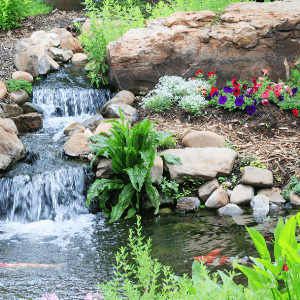
It includes paving, retaining walls, landscaping boulders, and landscaping blocks. The landscape consists of the plants you use to beautify your hard landscaping.
When landscaping with water, whether a koi pond or a fountain, think about how it will look and where it will go in your landscaped yard. Koi ponds, for example, can be built in a variety of locations.
However, you should ensure that they look lovely and that the landscaping stones blend in with the rest of your landscaping. You should also check to see if you need a permit to comply with local regulations.
Consider using some landscaping ideas that bring the outdoors closer to your home. Incorporating a lovely plant or two near the steps to your front door is a great way to welcome guests and add some green touches.
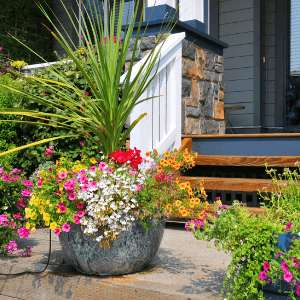
Potted plants that bloom in season don't even require a really green thumb! Make sure you pick plants known for being easy to care for since you will take care of them yourself.
A patio is a great landscaped yard feature that can dramatically change your house's look. You don't need just a plain old deck, either. Add some landscaping features like landscaping blocks, hanging pots and arches.
You can put landscaping pavers on it or add a fountain for an elegant touch. The landscaping ideas are endless!
When landscaping, the right kind of tree at the right place is critical. Make sure to choose trees wisely. Don't plant a tree where bushes can hide it.
Check out the landscaping trees that will last for years and add curb appeal to your house!
All open areas in your property are usable and can be transformed into an appealing spaces for your property. If you're worried that your landscaping is becoming too expensive, remember that regular landscaping maintenance is less expensive than allowing an area to become overgrown with weeds and brush. Plus, they detract from the aesthetics of your property.
Landscaping small areas can sometimes be tricky, but that doesn't mean it isn't worth doing. A landscaping project doesn't have to be a big backyard landscaping project.
Get landscaping ideas from things like mini landscaped beds or even window boxes. A slight touch of landscaping design can do wonders for your house!
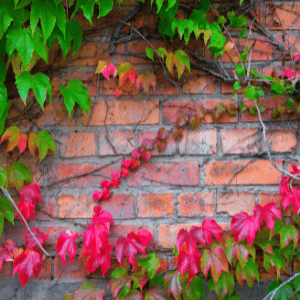
Using some landscaping pavers on landscaped walls is a great landscaping idea. You can also use it to break up landscaped beds and divide them into more sections. This landscaping idea is one of the easiest since you don't have to do anything except lay down the landscaping pavers on your wall.
Landscaping your landscaped yard is much easier if you let nature be. If you have any landscaped yards, landscaping maintenance can help you with landscaping ideas like this. Just leave the landscaping alone and let it grow on its own!
You might be surprised at how lovely they look on their own.
When landscaping your landscaped yard, landscaping maintenance is a must! Landscaped trees won't look as nice if they're overgrown, and landscaped bushes will soon look like weeds if you don't keep up with the landscaping.
Plan out landscaping ideas well, so you don't spend too much landscaping money on landscaped plants or landscaped trees.
Landscaping design is an art; landscaping ideas are endless if you get creative with landscaping things like landscaped borders, planters, or even landscaped gazebos. Check out different landscaping design ideas to see what landscaping style you prefer.
This is one of the best landscaping ideas if you're planning on landscaping your whole yard! If you don't know how to landscape well, find a landscaper that can give you some advice to follow.
Still intent on going at it your own way, don’t forget to learn some landscaping skills. Like any art form, landscaping takes time to learn!
Borders can look great in your yard or any other area with extra space. They are fantastic because they give the yard a finished and polished appearance! However, too many garden beds can make your yard appear cluttered and busy. Use them with caution.
The perimeter of your property would be ideal. Make a lovely flower border that will bloom continuously. Always plant taller plants in the back and shorter ones in the front. This will result in a very appealing color display.
Plant trees and bushes as close together as possible. It looks better if you group them to form a large cluster. This idea makes your yard look more organized and landscaped. It also gives the impression that the garden is fuller and has been there much longer.
This landscaping idea is popular among Niagara landscapers because it always makes it easier to know where your landscaped bed is. It creates a feeling of order in the garden.
Using landscaping rocks and stones to line backyard pathways is lovely and provides a more polished look.
If you have a big property, it can be challenging to determine where the outside world begins, and your yard ends. Landscapers in Niagara, where most properties aren't fenced, create borders using trees to give the landscaped yard a natural feel.
They're also not hard to maintain and don't cost much if you hire Niagara landscapers to help you.
Grouping bushes can make your landscaped yard look more professional if it faces a busy street. They are most effective in groups of two or three. Instead of flowers, you can use colored or variegated bushes.
Landscapers recommend using landscaping ties to create landscaped borders quickly. If landscaping rocks aren't available in your area, they make excellent substitutes.
You can also keep weeds away from the side of your house by placing them along the walls!
Planting vines is also useful for concealing a problem area, such as an unsightly compressor.
Landscapers recommend vines because they are common and readily available in Niagara landscaping supply stores. Furthermore, some of them can be very attractive, with large blooms that smell wonderful!
Conclusion paragraph: Simply put, landscaping is a great way to transform your yard and increase the value of your home. If you're looking for hassle-free ways to make your house stand out, try these ideas that are bound to impress!
We can help if you're trying to find the best landscaping in your neighborhood. Our expert professionals have years of knowledge and skill to execute any design or plan that you might come up with.
Since it will be customized to meet your needs and budget, we'll work closely with you to ensure that every detail is perfect. Landscaping St Catharines will be happy to handle the project from beginning to end, whether a small backyard revamp or a complete front yard makeover!
Contact us today if you'd like more information about our services or schedule a free consultation.
Mulch is an excellent item to add to your list of landscaping supplies in St. Catharines. Mulch is a material you layer on top of the soil to improve its quality.
Mulch is a landscaping material spread over the surface of the soil. Although mulch can be in the form of inorganic materials like pebbles or gravel, it is most frequently made from organic materials like bark, leaves, and wood chips.
Mulch helps to suppress weed growth, regulate soil moisture levels, and protect plants from extreme temperatures. Additionally, it can make your yard look more attractive.
Mulch comes in various forms, so choosing one appropriate for your needs is essential. For example, if you are landscaping a garden bed, you might select a mulch designed to improve drainage or one specifically made for use in gardens.
Apply the type of mulch you choose at the correct depth and reapply it as needed throughout the year. With some care and attention, mulch can help your landscaping look its best.
Mulch is one of the most crucial landscaping supplies for protecting and enriching garden beds. It helps to suppress weeds, retain moisture, and protect plants from extreme temperatures.
Mulch also provides a finished look to landscaping and can be used to add contrast and colour to garden beds. Some common types of mulch include bark, straw, leaves, and compost. When selecting mulch, it's also essential to consider the material's texture, colour, and size.
Landscapers in St Catharines can help you choose the right mulch for your landscaping project.
When it comes to landscaping, mulch is an essential tool. It can help to regulate soil temperature, prevent weed growth, and even improve the appearance of your garden. How can you choose the best one for your landscaping project?

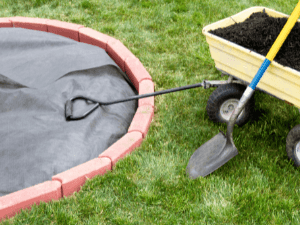
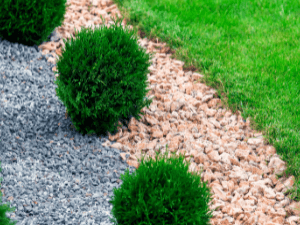
Gardeners should use organic mulch like wood chips or bark because it helps the soil become healthier as it decomposes.
Inorganic mulch, such as gravel or stone, doesn't offer the same benefits to the soil as organic mulch but can be a good choice for areas where you want to control weeds or prevent erosion.
This is a manufactured option that is usually made from plastic. It can effectively control weeds and regulate soil temperature but doesn't offer the same benefits as organic mulch.
Examples are black plastic, red plastic, and landscape fabric.
For most landscaping jobs, apply mulch at a depth of no more than 3 inches (7.5–10 cm). This will make sure that it effectively manages weeds and controls soil temperature.
Plastic sheeting can be used as mulch to help keep weeds at bay, but it's essential to use it carefully because it can degrade the quality of the soil if it's left in place for too long.
There is an ideal mulch for any landscaping project you're working on. So do some investigation to find the ideal type for your needs.
One of the most valuable and necessary landscaping materials is mulch. But how can you decide which form of mulch is best for your needs when there are so many different kinds available?
When selecting mulch, bear the following in mind:
On the other hand, you'll need a heavier, more durable mulch if you're trying to keep weeds from taking over your lawn.
There is a mulch type that is suitable for whatever kind of landscaping project you are working on. With the information provided in this post, you can find the best mulch. We'll also help you with other landscaping supplies you might need for your St Catharines landscape project.
Conclusion
Mulch is an essential tool for any landscaping project. It can help to regulate soil temperature, prevent weed growth, and even improve the appearance of your garden. Knowing what's suitable for your garden is essential to getting the most out of your mulch.
Now that you know all about mulch, it's time to get out there and start landscaping!
Need help with your landscaping project? Contact Landscaping St Catharines. We provide various services to help you get the most out of your outdoor space.
Your team at Landscaping St Catharines will be happy to help you choose the right mulch and other landscaping supplies for your needs and even deliver them right to your door. So don't wait; let us help you transform your outdoor space!
Landscapers can bring you some fabulous ideas if you want to give your property in the Niagara region a facelift and make it more presentable.
Here is a list of twenty things you can do to your outside area to improve its aesthetic appeal.
Shade, a boost in property value, and the ability to breathe cleaner air are just a few of the many reasons trees are lovely additions to any yard.
Grass is another living element of your garden that will help draw buyers when it comes time to sell your house. For instance, planting bamboo or hostas is an excellent way to achieve a distinctively different appearance.
Not only can fences help keep children and dogs safe, but they may also define your yard and make your landscape look more appealing to the eye.
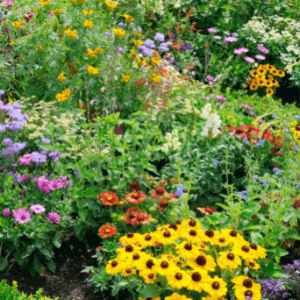
Planting flowers and vegetables in several garden beds is a terrific way to give them some life.
Adding another level to your home will give you more space for entertaining. There are also many practical reasons to have decks and pergolas built in your backyard—from giving yourself extra room to relax outside to providing shade.
During the warmer months, it will be much simpler for you to organize get-togethers if you have an outdoor fireplace, which will allow you to invite your friends over for dinner and make it easier for you to do so.
Adding a few shrubs is a great way to provide privacy between your home and the street. You can also build fences or plant hedges if searching for something more durable.
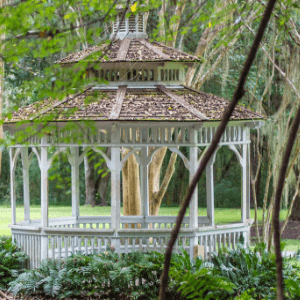
Gazebos might not be an essential part of the landscaping, but they help create more outdoor space. Gazebos can serve as a place to eat, entertain or relax on sunny days.
Your property will appear well-kept and inviting if it has a little pathway that some stones or potted plants border. This effect can also accentuate the walkway if illuminated by a few outside lights.
Adding lights to your home's front entry or along its pathway will make it more appealing and easier for you and your guests to locate your property during the evening hours. These could be solar lights so it would be easier on your utility bill.
If you want to create something in your yard that will set it apart from the other landscaping in the neighbourhood, you can always build a small fountain or waterfall. You should consider this if you want something that will make your landscaping stand out.
Having bird feeders in your yard is easy to bring the outdoors closer and attract beautiful birds to enjoy watching.
Growing your herbs is easy and cost-effective, so you can easily do it if you want to make your pesto or add some fresh herbs to your supper. Additionally, you can cultivate flowering herbs like lavender, bee balm and chamomile in containers and place them on your patio, deck, or porch.
You can achieve a more natural appearance in the yard by scattering a few logs around the space; for an additional spot to sit and unwind, you can even place logs for seating. Adding stones or pebbles in various sizes can also enhance your walkway.
Installing accent lighting beneath the soffits of your home is a simple yet effective way to draw attention to the architectural features of the outside of your home. A well-lit appearance can also be achieved in the evening in your home by putting spotlights, lanterns, sconces, and globes on the exterior of your home. This is another option.
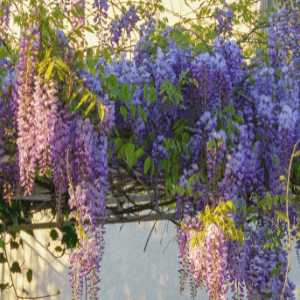
Your home will look livelier and more interesting if you place a few shrubs or plants around its foundation. This will give the appearance of more depth.
Your children will have much more fun in your backyard if you install a slide or a swing set. This is a simple method to make your backyard more inviting for them. It is also much easier to watch them while playing outside.
If you have a small space available, you can grow fruit trees and enjoy the delicious fruits they produce. There are a few solutions available if you don't have much room. Apple and pear trees that are potted or espaliered are wise alternatives.
You may increase your entertaining space by adding a pergola, and you can even have one built that is large enough for your guests to gather in the event of rainfall or excessive heat.
Create a space for enjoyment out of something like a shed for storage or a playhouse for kids. It is a fun undertaking. Painting the walls and installing lighting can add much to this fantastic outdoor living area.
If you don't have enough time or resources to finish all of these projects, it is worthwhile to get help from a reputable landscaper for the projects you can choose from this list. However, this list is an excellent place to start if you're searching for suggestions on how to enhance your outdoor living space—and possibly increase the value of your property at the same time.
In Niagara, working with seasoned landscapers is something to consider for completing your project. Niagara landscapers can advise you on which projects are suitable for your present level of experience.
Contact professional landscapers in Niagara today for some needed help with any project from laying sod, planting flowers, mowing grass, or anything else included on this list.
For more information, contact Landscaping St Catharine.
While there are many strategies to reduce the cost of landscaping projects, utilizing one of several local landscaping companies in St Catharines is one of the best. Numerous excellent landscaping businesses in St. Catharines can help you cut costs on your job. Some of the best are as follows:
Not only will they take care of all the hard work for you, but they can also provide you with expert advice on maintaining your yard. In addition, landscaping companies often offer discounts for those who sign up for regular services.
As a result, hiring a landscaper can save you both time and money in the long run.
Beautiful landscaping in St. Catharines doesn't have to cost a fortune. There are many landscaping companies St Catharines that will give you a free estimate.
You'll be surprised at how much you can save. And, of course, landscaping companies will be more than happy to come out and take a look at your property.
They have excellent recommendations for landscaping improvements that won't break the bank. Call right away to start saving money on your landscaping.
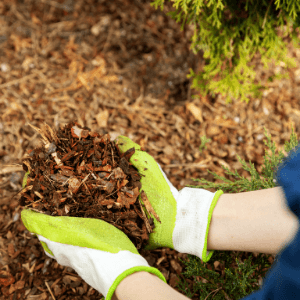
Many landscaping companies in St Catharines use mulch to help save money and time. By using mulch, landscapers can reduce the amount of time spent weeding garden beds, as well as the need for herbicides and pesticides.
Mulch also aids in the retention of soil moisture, which reduces the amount of water required to maintain plant health. Mulch can therefore assist landscapers in reducing labour and water expenditures.
In addition, mulch can also add aesthetic value to a garden bed, providing a tidy, finished look. For these reasons, it's no wonder that more and more landscapers are using mulch to save money and time.
Landscaping companies in St Catharines can be expensive, but there are ways to save money and still have a beautiful yard. One way is to go for plants that are easy to maintain.
Landscapers advocate native plants because they're used to the temperature and soil. Choose low-maintenance plants that don't need much watering or maintenance.
These types of plants are often drought-resistant and can tolerate different types of weather conditions. By choosing plants that are easy to care for, you can save money on landscaping companies in St Catharines and still have a beautiful yard.
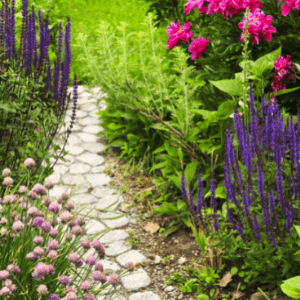
If you're looking to save money on your landscaping costs, one of the best ways to do it is to use perennials instead of annuals.
You don't need to replant perennials every spring because they grow back year after year. In contrast, annuals have a single season of growth.
Not only does this mean that you'll have to repurchase and replant them every year, but it also means that they'll need more water and care to stay alive. As a result, using perennials can help you save both money and time in the long run.
So, instead of utilizing annuals the next time you landscape your yard, think about incorporating some perennials. Long-term cost savings will result from this wise decision.
Caring for your landscape will change when you replace the lawn with a ground cover. For one thing, you'll be weeding instead of mowing. The groundcover can potentially take over your property.
Opting for groundcovers instead of a grassy lawn may require phasing in the change to avoid extra maintenance. After three years or so, depending on spacing, the ground cover should require less upkeep.
Without regular lawn maintenance, restoration and reseeding, weeds can take over lawns and change the surrounding landscape. These services require time, energy, and resources.
Several low-growing, ground coverings are available. Some are even "pedestrian friendly" which are evergreen—green foliage year-round!
Also, some of these groundcovers flower and will change your landscape each season. Many of these plants are drought-tolerant, having species for sun, shade, and in-between.
Without a doubt, long-term savings are possible when you choose to replace your grass with groundcovers.
Landscaping companies in St Catharines often suggest that homeowners group plants together to save money. After all, it is more efficient to landscaper one large bed than several small ones.
Furthermore, clustering plants can frequently produce a more striking impact than spreading them out. When landscaping your yard, take into account grouping plants with comparable water and light requirements.
You'll spend less time watering and taking care of your plants as a result. Additionally, it will ensure that the next time you plan your landscaping, you keep in mind that grouping plants together might help you save time and money.
Landscaping companies in St Catharines often suggest that homeowners group plants together to save money. After all, it is more efficient to landscaper one large bed than several small ones.
In addition, grouping plants together can often create a more dramatic effect than spreading them out. Consider grouping plants with similar water and light needs when landscaping your yard.
This will reduce the time you need to water and care for your plants. It will also help to ensure that all of your plants thrive.
So next time you are planning your landscaping, remember that grouping plants together can save you both time and money.
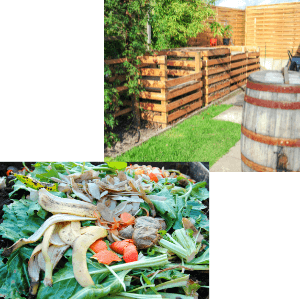
If you want to fertilize your plants affordably, think about using compost. Compost is made from organic waste like leaves, grass clippings, and kitchen leftovers.
Recycling these materials allows you to create a nutrient-rich soil amendment to help your plants thrive. Plus, composting is a great way to reduce your St Catharines' carbon footprint.
If you're not sure how to get started, many St Catharines landscaping professionals offer composting services. Or, you can learn to make your compost at home.
Using compost is a smart way to save money and help the environment.
In conclusion, there are many ways to save money on landscaping in St. Catharines. From using perennials instead of annuals to watering deeply but infrequently, these tips can help you keep your landscaping costs down.
So next time you are planning your landscaping, keep these money-saving tips in mind. Your wallet will thank you!
Serving the Niagara region for more than 20 years is Landscaping St. Catharines. Our family-run landscaping company takes great pleasure in the quality of its work.
We are skilled in every facet of landscaping, such as design, paving stones, retaining walls, sodding, planting, interlocking, decks and fences, and much more.
We also do fall and spring clean-ups as well as snow removal in the winter.
Whatever your landscaping requirements, we can help! Call us right away for a cost-free quote!
Avoid these six typical garden design mistakes when planning your landscaping in St. Catharines, Ontario! A beautiful garden requires patience, time, and effort to create. Look no further! We'll help you design a lovely and practical outdoor area with this article.
However, even the most seasoned gardener can make errors.
Gardeners in St. Catharines must consider the climate while planning their landscapes. St. Catharines is within zone 7a, which implies that over the year, the temperature typically varies from-17.8°C to -15°C, according to the Canada Plant Hardiness Zone Map.
As a result, gardeners must select plants that can survive in zones 7 or lower. If not, their plants won't make it through the winter.
How much sunlight the garden will receive is another factor. While some plants like full sun, others thrive under some shade. The plants that gardeners select must be able to grow in the amount of sunlight that the garden receives.
By considering the climate, gardeners can ensure their garden flourishes with plants that provide a lovely space.
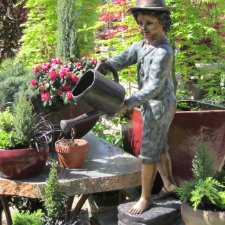
A garden should have a central focal point, the basis of the rest of the design. This could be a stunning piece of garden art, a low stone retaining wall, an architectural feature, or a beautiful plant. Without a focal point, a garden can appear undefined and unfinished.
Furthermore, failing to create a focal point can make it challenging to plan the rest of the garden, as there will be no clear starting point from which to build.
Landscaping your St. Catharines property can be easy as long as you know the basics of landscaping. One of the essential aspects of garden design in St Catharines is choosing the proper edging for your garden beds.
Edging helps to define garden beds and can also help to prevent weeds from spreading. There are many edgings available, so choosing one that will complement your garden style is crucial. Brick edging is popular for formal gardens, while stone or wood edging can suit informal gardens.
No matter what kind you choose, make sure to put it in the right way so it will last for years.
Ignoring the value of mulch can be turn into a big design mistake for your St Catharines property. Gardeners and landscapers in St. Catharines often use mulch to stop weeds from growing, save water, and maintain soil temperature.
Cosmetically, it helps your environment look better overall. Mulch comes in various forms, including organic (such as bark, wood chips, and leaves) and inorganic (rock, gravel).
Your garden's requirements and personal preferences will determine the kind of mulch you select. Whatever type of mulch you choose, spread it out evenly and keep the thickness at 3 to 4 inches (8-10 cm).
Your garden will benefit from all of the mulch's advantages.
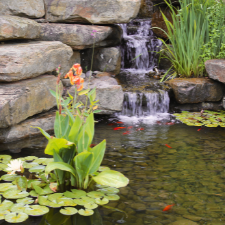
The presence of a water element can significantly improve the garden's already serene and lovely atmosphere. Running water is believed to be calming and can be used to cover up undesirable sounds from nearby homes or busy streets.
In addition to attracting animals like birds and butterflies, water features can enhance the attractiveness of your garden. However, many gardeners skip including water elements in their plans because they believe they are too expensive or challenging to manage.
In truth, with some preparation, water features can be simple to construct and maintain and provide advantages that make an effort well worth it.

Even though it is a crucial element of any landscape design, ignoring good lighting frequently happens. A well-lit garden can draw attention to specific components, feel more attractive at night, and even keep pests away.
It is critical to select the right fixtures for your space from among the many different types of garden lighting that are available. Incandescent bulbs light up a landscape but are economical because they are cheap and give off a warm, friendly light.
However, because of their high energy efficiency and lengthy lifespan, LED lamps are growing in popularity. To choose garden lights that will offer the proper amount of light for your garden, consider the bulbs' wattage, beam angle, and color temperature.
Gardening is a beautiful way to enhance the beauty and value of your house, but it's crucial to avoid frequent blunders that can destroy your landscape.
By following the suggestions in this article, you can create a stunning garden design in St. Catharines that fulfills both aesthetic and functional needs. Go outside and begin your gardening, then!
Do you want to take your home's curb appeal to the next level? Hiring a reputable landscaping business can make a huge difference. The experts at Landscaping St. Catharines can make your outdoor space look fabulous.
They will work with you throughout the entire process to design a garden that satisfies your demands and enhances your property. In addition to landscape planning and design, they offer services like planting trees, taking care of lawns, and keeping gardens in good shape.
So, if you need help making changes to your home, call the Landscaping St. Catharines experts.
Plants play a major role in landscape design In St. Catharines. Making the proper plant selections that are compatible for this region is much more important. When choosing plants, they would have taken into account the type of soil, water drainage capacities, and sun exposure.
Garden aficionados and professional landscapers alike have done the city a great favor. As a result, giving it the well-known moniker, The Garden City.
With this article, we hope we can help keep St Catharines maintain its landscape design fame by helping you choose the right plants for your yard. Here are the considerations.
Test the pH and nutrient levels of the soil in your yard before choosing your plants. It is feasible to utilize the edge of a plant leaf if you don't have a kit.

Watch what happens to the leaf when you place it in a glass of water. If the leaf turns a deeper shade of green, the soil is acidic. If it turns yellow or brownish, the soil is alkaline. Anything in the middle is neutral soil, meaning there is no pH shift.
You can also mix some of the soil with dish soap and water. If it foams, your soil is acidic; if it doesn't, it's alkaline.
You can buy kits that determine the pH levels but these are a bit pricey.
After identifying your soil type, you can choose what to plant in your soil. For example, if your soil is alkaline, stay away from plants that require acidic or neutral soils because they won't do well.
So, before you bring home that plant and place it in the soil of a new yard, you should know what kind of soil it needs to grow well. Listed below are some plants that love clay soils: Irises, Japanese blood grass, cranesbill geraniums (both blue and red), hosta, colocasia, rhubarb and angel’s tears.
For sandy soils, you may grow plants like rex begonia, liriope (lilyturf), garden phlox or sweet woodruff.
Some plants also have additional requirements. Examples are plants of the mint family, which need well-draining soil since they cannot tolerate having their feet wet. Compact, clayey soil cannot support plants that have long taproots like so many root vegetables.
Your water supply is a further significant factor to take into account. How much water do the plants and your lawn need? Is there enough rain? All of these things should be taken into account. If there’s not enough water, your plants will die or be severely compromised.
Plants will require more water when there is little rainfall. If drip irrigation has been set up, it is an excellent method since it uses a network of pipes and tiny holes to transfer water directly to the roots without wasting a drop.
On the other hand, excessive watering and rainfall might kill your plants by generating root rot, which will ultimately kill your plants. Check the soil around your plants frequently to make sure you aren't overwatering them or that it isn't too damp.
Light Exposure
Plants need natural sunlight but some require more than others. It all depends on the type of plant you have. Some need full sunlight while others can manage with just 4 hours of sun exposure a day.
Some plants need to be in the shade and cannot tolerate strong light at all. If you want to grow things like violets, coral bells, astilbe, or impatiens then your yard may be a suitable place for them as it will provide the shady spots they need.
The hot sun is damaging to some plants so have enough shade trees and shrubs in your yard for them. Apple trees, crab apple trees and other fruit producing tree varieties thrive in full sunlight but you may also plant flowering cherry or lilac trees to complement your garden plan.
If you live in a flat area, you can grow practically any plant in your yard. If not, consider how steep your terrain is and make the appropriate preparations. To have a clear view of the entire yard from one central location, you might need to excavate terraces or create other arrangements.
Although it's a popular myth, soil doesn't always need to be 12 inches deep for plants. Some plants can thrive on a topsoil layer as thin as 2-3 inches and some can even survive with only 6 inches of soil covering their roots.
However, you need to have deeper soil if you intend to produce crops like maize or potatoes in your vegetable garden. Considerations like the depth of the frost on sloped terrain and other elements that affect soil depth may also be necessary. The type of plant you wish to cultivate will determine how much topsoil is "enough."
If at all feasible, pick flexible, versatile plants that don't require deep, loose soil. Choosing native plants is wise because they can survive in the kind of soil that exists around them and don’t need changing to grow well.
Read our blog page for more tips on starting and maintaining a landscape design in St Catharines!
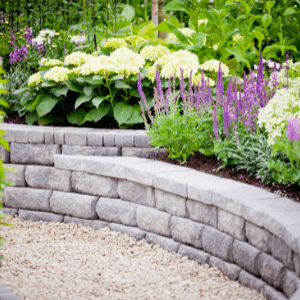
Your yard should ideally be planted with blooming plants, such as flowers and trees or bushes. Along one side of your home or doorway, you could also build an arbor so that you can hang potted plants there in the winter.
Fences or other structures should not interfere with the landscape design of the yard itself. Choose flowering vines like Chinese Wisteria (Wisteria sinensis), Boston Ivy (Parthenocissus tricuspidata), Climbing Hydrangea (Hydrangea anomala ssp. petiolaris), Japanese Honeysuckle (Lonicera japonica).
An arbor can be used by birds for nesting and will provide visual appeal year-round to your outdoor living space.
They are also excellent for hanging baskets and potted plants during the winter and as a way to provide shelter from the blazing sun in the summer.
Add other outdoor structures like gazebos, pergolas, and retaining walls to your landscape design in St Catharines even more stunning!
Keep your bird feeders and birdhouses clean at all times if you have them outside. This will motivate birds to return. If you live close to a forest, plant bushes that produce food sources like berries or nuts, which will regularly draw wildlife into your yard.
If at all possible, avoid using insecticides around these trees. Additionally, if you intend to cultivate any edible plants in your garden, ensure pests can't get in.
Keeping a compost pile in a yard corner is an additional option. This will draw birds and squirrels, which will scatter seeds and food throughout your garden.
The theory is that by positioning your compost pile where it is visible to you, you’ll be more likely to keep an eye on it and monitor its activity closely.
If you see rodent activity then consider setting up a rat trap or two around the compost itself for added protection against unwanted pests and vermin.
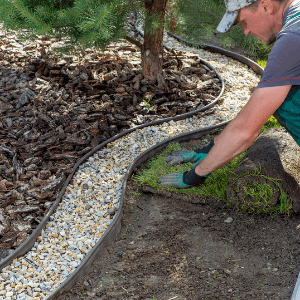
You can create the landscape design of your dreams with the help of Landscaping St. Catharines! Maybe you've seen some of our landscaping projects around the neighborhood and are now ready to start your own.
We provide first-rate service at affordable prices without any additional expenses. Check out our monthly maintenance package options.
Give us a call and one of our experts will be pleased to answer any questions you may have about who we are or what we do. Call right away to schedule a free estimate. We look forward to hearing from you soon!
If you're looking for ways to save time and money on lawn care in Pelham, a monthly lawn maintenance schedule is the way to go. So by following a set schedule of activities, you can keep your lawn healthy and looking its best without having to put in a lot of extra work.
But with so many different monthly landscaping maintenance packages available how do you know which one is right for your lawn?
Here are a few factors to consider when choosing a monthly maintenance package:
The larger your lawn, the more time and effort. It will take to keep it looking its best. If you have a large lawn, you'll need to choose a monthly package. Ensure that it includes more frequent visits from the landscaper.
Different types of grasses require different care and attention. If you're not sure what type of grass you have, ask your local nursery or landscape company for advice. They'll be able to recommend the right monthly package for your lawn.
Monthly landscaping maintenance packages can vary widely in price, so it's important to choose one that fits within your budget. Be sure to get quotes from several different companies before making a final decision.
By taking the time to consider these factors, you can be sure to choose the right monthly landscaping maintenance package for your lawn.
For expert advice on lawn care in Thorold, contact Landscapers Niagara. We'll be happy to help you create a customized monthly package that's perfect for your lawn!

Here are some tips for creating a monthly maintenance schedule that will work for you:
The first step is to figure out what tasks need to be done monthly to keep your lawn healthy. This will vary depending on the type of grass and climate you have, but some common monthly tasks include mowing, watering, fertilizing, and aerating.
Once you know what needs to be done, you need to decide when you will do each task. For example, if you plan to mow your lawn every week, you will need to schedule that into your monthly maintenance schedule.
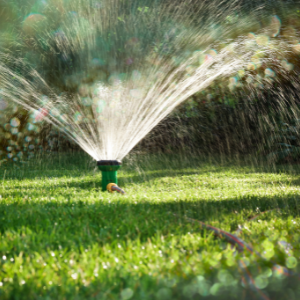
It's important to set reminders for yourself so that you don't forget to complete your monthly lawn tasks. You can set alarms on your phone or calendar, or write yourself notes to remind you. Then, do your monthly lawn care maintenance in your lawn in Pelham.
Some people prefer to complete all their monthly lawn tasks on the same day each month, while others prefer to spread them out throughout the month. Choose a day or time that works for you and fits into your schedule.
The key to a successful monthly lawn maintenance schedule is consistency. If you only complete your tasks every other month or whenever you remember, you won't see the benefits of having a schedule. Make sure to stick to your plan so that you can enjoy a healthy and beautiful lawn all year long.
As you follow your monthly lawn maintenance schedule from you Pelham home, you may find that certain tasks need to be done more or less often than you originally thought.
For example, if you're mowing your lawn every week but it's not growing very quickly, you may only need to mow every two weeks. Or if your grass is growing quickly but always looks a little dry, you may need to increase your watering schedule.
Be sure to adjust your schedule as needed based on the results you see so that you can keep your lawn healthy and looking its best.
Following these tips, you can create a monthly landscaping maintenance schedule that will work for you and your lawn. If you need help getting started, contact a local landscaper in Thorold who can assist you in creating a custom plan for your lawn.
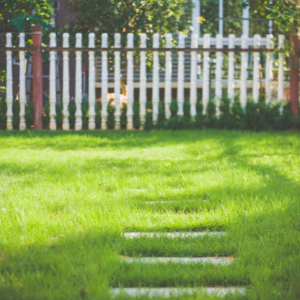
By following a monthly lawn maintenance schedule, you can save time and money while keeping your lawn healthy and beautiful. So sit back, relax, and enjoy your lawn knowing that it's being well-cared for.
For more helpful tips on lawn care, be sure to check out our blog at Landscaping St Catharines. We regularly post new articles to help you keep your lawn looking its best! Click the link to read more: https://landscapingstcatharines.com/blog.
Landscaping St Catharines can help you get the landscape of your dreams! Click on the button below!
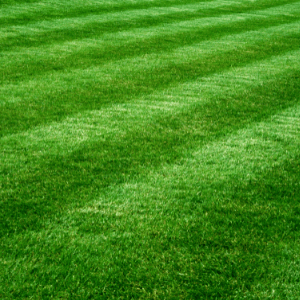
Maintenance packages are the way to go if you're looking to save time and money on your monthly landscaping budget! Following a set monthly schedule of tasks, you can keep your lawn healthy and looking great - without putting in a lot of extra work.
So what does monthly landscaping maintenance include? Read on to find out everything you need about these helpful services.
Most monthly landscaping packages will include the basic maintenance tasks necessary to keep your yard looking its best.
By signing up for a monthly package, you can ensure that your yard will always look its best without lifting a finger.
Plus, monthly packages are often very affordable, making them a great option for budget-conscious homeowners.
Monthly landscaping packages typically include:
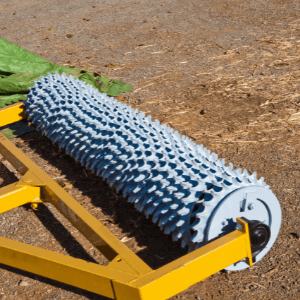
For many people, monthly landscaping maintenance is the key to having a beautiful lawn that is the envy of the neighborhood. However, there are other landscaping tasks that may be needed and could also be a lot of work.
That's why some companies offer additional services such as leaf removal, aeration, and power raking. These services can help take some of the work out of monthly landscaping maintenance.
Leaf removal can help in the fall when leaves are falling from the trees and covering the lawn.
Aeration can help improve the lawn's health by allowing air and water to penetrate the soil more easily.
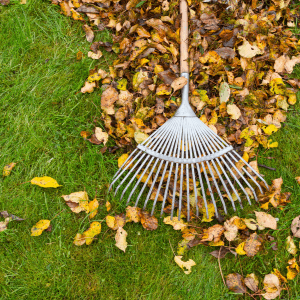
And power raking can help to remove dead grass and debris from the lawn, leaving it looking clean and fresh. So if you're looking for a little extra help with your monthly landscaping maintenance, consider these additional services.
Additional services:
By signing up for a monthly package, a crew can take care of all your landscaping needs - so you can enjoy your beautiful yard all season long!
There are many reasons to opt for monthly landscaping services, including convenience, savings, and peace of mind.
Once you've signed up for a monthly package, you can forget about scheduling landscaping appointments yourself. Your lawn care provider will take care of everything for you and you can then focus on other things.
Monthly packages usually come with a discount, so you'll save money in the long run by signing up for regular service.
Knowing that your lawn is being taken care of by professionals will give you peace of mind and help you relax and enjoy your free time.
Before you sign up for monthly landscaping, there are a couple of things you'll need to consider.
First, consider your budget and how much you can realistically afford to spend on lawn care each month.
It's important to shop around and compare pricing before making your decision.
Second, think about the size of your yard. The larger the property, the more you can expect to pay for monthly landscaping.
Finally, consider your needs and what services you're looking for. Do you need someone to mow the lawn, or do you require more comprehensive services? Make sure to communicate your needs to potential providers to find the best fit for you.
Make sure to communicate your needs to potential providers to find the best fit for you. Now that you know all about monthly landscaping packages, it's time to start shopping around!
Use the tips in this article to find a package that fits your needs and budget. Then sit back and relax while your lawn is taken care of - without lifting a finger!
Maintaining a well-manicured lawn can be a monthly chore, but it's well worth the effort.
A healthy lawn not only looks great, but it can also help to improve your home's curb appeal and potentially increase its resale value. And while monthly lawn care may seem daunting, there are a few simple steps you can take to make the process easier.
First, look at your lawn and determine how often it will need to be mowed. Most grasses need mowing every one to two weeks, but this will vary depending on the type of grass and the height you keep it trimmed at.
You'll also need to factor in the time of year - during the summer months, you may need to mow more often as the grass grows more quickly.
Next, consider edging and trimming. This is typically something that needs to be done every two to four weeks, although, again, it will vary depending on your particular lawn. If you have a lot of landscaping features or obstacles in your yard, you may also need to trim more often.
Fertilizing is another important step in monthly lawn care. Depending on the grass you have, you'll need to fertilize anywhere from once a month to four times a year.
And don't forget about watering! Depending on your climate and the time of year, your lawn may need to be watered daily or just a few times a week.
Weed control should be done every 2-4 weeks. Leaf removal should be done as needed (usually 1-2 times per month). Aeration and power raking should be done once a year.
Following a monthly lawn care schedule ensures that your lawn stays healthy and looks great all year long! So don't wait - start shopping around for monthly landscaping packages today!
Monthly landscaping maintenance is a great option if you're looking for ways to improve your home's curb appeal.
By following a set monthly schedule of activities, you can keep your lawn healthy and looking its best - without putting in much extra work.
Plus, with Landscaping St Catharines, you can be sure you're getting the high-quality services you deserve.
We are proud to offer our monthly landscaping services to homeowners in:
If you're unsure if we service your area, please don't hesitate to contact us, and we'll be happy to assist you. Contact us today to learn more about how we can help you achieve the lawn of your dreams!
A beautiful landscape design in St Catharines will turn heads and will increase your home's value. This are just two reasons many homeowners invest in it. More than ever, with fierce competition in the real estate market, improving your home's curb appeal should be a priority.
You can do many things to improve your garden's curb appeal. If you are a property owner looking for ways to make your garden's curb more attractive, look no further!
This blog post will give you 15 easy steps to make your garden more attractive.
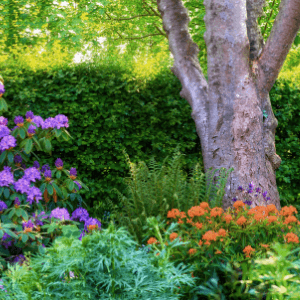
Flowers in various colors and textures can make your garden more attractive. For example, planting pink or red roses will add color to the environment.
Adding flowers with different heights, including some shorter ones like daisies, could also help create interest for viewers because it'll be easier for them to see all parts of the flower from different angles.
If you have a bigger yard, planting flowers in the back and front of your property will also help increase attractiveness because it'll be more visually stimulating when they walk or drive by.
Not only does having plants add color to the environment, but they can also provide shade for individuals who are strolling through during hot days.
Individuals interested in attracting birds to their yard can plant flowers that will attract them with the added benefit of creating a nice environment.
Trimming your trees and bushes can also help improve the curb appeal of your garden. Overgrown trees and bushes can make your property look unkempt and messy.
Trimming them will give you the appearance of a well-groomed and organized garden. In addition, trimmed trees and bushes can also provide more sunlight to reach your other plants, which can help them grow better.
Edging your lawn gives it a clean, finished look. It also makes it look like you take pride in your home and yard. Edging is easy to do and only takes a few minutes, but it can make a big difference in the overall appearance of your garden.
Weeds can make any yard look bad. Take the time to pull them, so your yard looks its best.
Adding a layer of mulch to your garden can help improve its appearance in several ways. First, it can help control weeds by smothering them and preventing them from growing.
Second, it can help retain moisture in the soil, which benefits your plants. Third, it can add color and interest to your garden. There are many different types of mulch available, so you can choose one that best suits your needs.
Nothing looks better than a well maintained yard. Green grass cut to the right height and never overgrown or dried up - all these things are possible if you have a professional lawn care team taking care of it.
Bare spots in your lawn can make it look patchy and unhealthy. To fix this, plant grass seeds in the bare spots. You can do this in the spring or fall.
Watering your plants regularly is important for their health and growth, but it can also help improve the appearance of your garden. Plants that are wilted or dry tend to look unkempt. By watering them regularly, you can keep them looking fresh and vibrant.
Adding a garden bench or other type of seating to your property can provide a place for people to sit and enjoy the view of your garden. It can also be used to rest when working in the garden.
Benches come in various styles, so you can choose one that best fits your needs and the overall look of your garden.
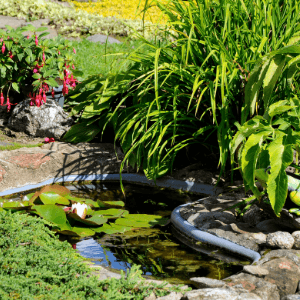
Adding a small pond or other type of water feature to your garden can help attract birds and other wildlife. It can also add a calming and relaxing element to your yard. Mini pond liners come in many different styles, so you can choose to go with your own shape using a rubber liner. Choose what best suits your needs and the look of your garden.
In the last few years this has become quite a popular feature in St Catharines landscape design and we're still seeing more properties adding this feature.
A small fountain in your garden can add both beauty and sound. A little running water will look pretty, and the soft bubbling noise is soothing for many people.
It may also help keep pests or neighborhood animals away from your plants because they don't like the same sounds humans do. Installing a pond liner before the fountain is an easy way to save money on plants that need a lot of water.
One way to improve your garden's curb appeal is by adding a bird feeder. Birds can add beauty and sound to any outdoor space while also helping control pests that may damage the plants in your yard.
Depending on your preference, you can choose to have one or several bird feeders.
A popular option is the hanging platform feeder because it allows you to observe different birds that come by for a meal, including cardinals, blue jays, finches, chickadees, and more!
Using lighting to highlight certain features in your garden can help improve its overall appearance. For example, placing lights around a bench or water feature will make it more visible and inviting.
Solar lights in the garden are a good option because they are environmentally friendly and easy to install.

Adding a trellis or arbor will add some height to your garden. This can make the design more interesting and attractive, especially if you plant tall flowers. If you do not have enough space for an arbor, consider adding one of our beautiful pergolas instead!
A couple white trellises or a more grand pergola will add a delightful element to your St Catharines landscape design!
The finishing touch of a beautiful garden lives up to the appearance it is given. Keeping your garden tidy and free of dead plants and weeds shows off its beauty.
Get rid of unsightly leaves and other debris that may be cluttering your garden. A well-kept lawn always shows that the homeowners are dedicated to caring for their home.
Other chores we tend to neglect include brushing out the dirt from your potted plants to make them look clean.
Some people like moss on their clay pots while others don't — scraping it out can avoid making your garden unattended.
Your garden's curb appeal is the first thing people see when visiting. Improving your home's curb appeal can help your visitors make the right impression. It's time for your yard to get an update!
Hiring professional landscapers can help turn any yard into an extension of your home. An excellent landscape design makes everything in your St Catharines yard look beautiful.
For more interesting tips, be sure to check: https://landscapingstcatharines.com/blog/.
Contact Landscaping St Catharines today if you would like more information about how we can improve your garden's curb appeal.
A rockery is a beautiful and unique addition to any garden and can be created with the help of St Catharines landscape supply. In this guide, we will show you how to build a rockery that will be the envy of your neighbourhood.
Building a rockery is not as difficult as you might think. With a little bit of planning and preparation, you can create
Do you want to add more garden features? If yes, then is this the sign for you to build rockery?
Rockery contains arrangements of different rocks and alpine plants. This feature suits any size of the garden. Rockeries are the focal point of landscaping. The use of rock as garden decoration started long ago and can be traced to the early Japanese and Chinese gardens.
A rockery is a great addition to any landscape. Use it to add height, interest, and texture to your garden. Rockeries can also help control erosion on sloped areas of your property. You can pick up all your materials from your local St Catharines landscape supply.
The rockery is a unique and beautiful way to decorate our garden. The colourful stones and plants around it could make any corner of our yard eye-catching. Also, they are simple to create by yourself. You can do this with your family.
Recreational activities like this are fun and interactive to do. Plus, you're not just making your yard pretty, but you could save lots of money.
So, are you ready to make your rockery? Follow the listed instructions to achieve your ideal rockery in your yard.
You can find these materials at any St Catharines landscape supply near you.
The best place to build your rockery should have good drainage. It should also be in an area with at least six hours of sunlight a day. If you have these two things, you're well on your way to creating a beautiful rockery.
Once you've chosen the perfect location, it's time to start planning your landscape design.
Start by sketching out your design on paper. This doesn't have to be perfect - just a rough idea of what you want your rockery to look like. Once you have a general idea, it's time to start gathering your materials.
Without a doubt, choosing the right rocks is one of the most important aspects of creating a beautiful rockery. You'll want to choose rocks of various sizes and shapes to create an interesting and visually appealing design.
If you're unsure where to find rocks, your local St Catharines landscape supply should have a wide selection.
Once you've gathered your materials, it's time to start preparing the area where you'll be building your rockery. Start by removing any weeds or grass from the area. Then, use a garden hose to outline the shape of your rockery.
Next, dig a trench around the perimeter of your rockery about 6 inches deep. Once you have your trench, line it with landscape fabric. This will help prevent weeds and grass from growing up through your rockery.
Now, it's time to start filling in your rockery. Start by adding a layer of peat moss, then a layer of the compost mix. Next, add a layer of sand. The sand will help drainage and prevent your rocks from shifting.
Now it's time to start building your rockery. Begin by placing the largest rocks first, then fill in the gaps with smaller rocks. As you're building, be sure to leave gaps for plants.
Once you've finished building your rockery, it's time to add some plants. Alpine plants are a great choice for rockeries because they don't require much maintenance. You can find a wide array from your St Catharines landscape supply. Dig a hole in the sand, add some compost mix, and plant your alpine plant.
Sedum is a hardy, drought-tolerant plant that comes in various colours. It's a low-maintenance plant that doesn't require much care. To plant sedum in your rockery, dig a hole in the sand and add some compost mix.
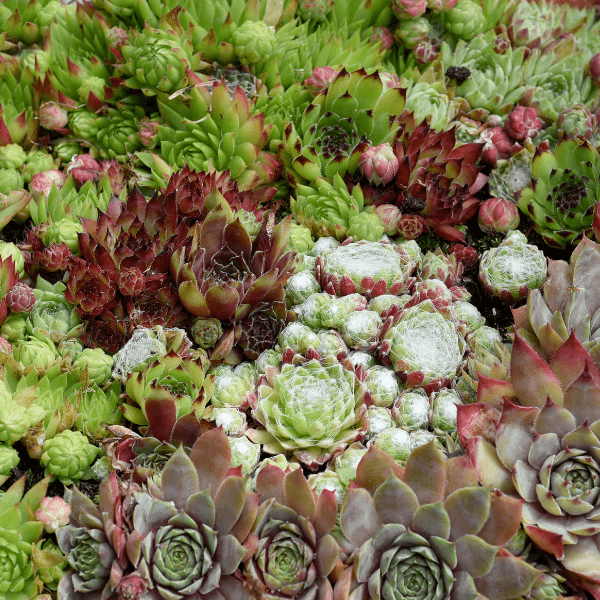
Sempervivum is another hardy, drought-tolerant plant that is perfect for rockeries. It's available in various colours and forms and is easy to care for. To plant sempervivum in your rockery, dig a hole in the sand and add some compost mix.
Jovibarba is a genus of plants in the family Crassulaceae. The common English name is houseleek. Plants in this genus are native to Europe and Asia. They are succulent perennials that grow in rosettes.
The leaves are fleshy and often have hairs or spines on them. The flowers are small and borne in clusters.
To plant Jovibarba, choose a well-drained spot in full sun to partial shade. Loosen the soil and dig a hole twice the width and depth of the pot.
Gently remove the plant from its pot and place it in the hole so that the top of the root ball is level with the soil surface.
Backfill with soil and water well. Apply a mulch to help keep the roots cool and moist.
Orostachys is a genus of succulent plants in the family Crassulaceae. It contains about 24 species, all native to eastern Asia. The name is derived from the Greek oros meaning "mountain," and Stachys meaning "spike", referring to the inflorescence of some species.
Common English names for Orostachys include mountain jewel orkydium and Roseroot. Plants in this genus are small, evergreen succulents with rosettes of fleshy leaves. They produce cylindrical spikes of small flowers in summer.
Orostachys are easy to grow in well-drained soil from full sun to partial shade. They are tolerant of poor soil and drought. To propagate, divide the offsets or take stem cuttings in spring or summer.
Delosperma, also known as ice plants or Trailing Ice Plants, is a genus of flowering plants native to Southern Africa. They are well-suited for planting in rockeries due to their low growth habit and ability to thrive in dry, rocky conditions.
Delosperma can be propagated from seeds or cuttings. To sow seed, surface sow onto a well-drained seed mix and keep moist until germination.
Cuttings can be taken from healthy stems in spring or summer and rooted in a propagator with bottom heat. Once rooted, you can transplant them into the rockery.
The common English name for Helianthemum is rock rose. It is a low-growing, evergreen shrub with small, yellow flowers.
To plant Helianthemum in the rockery, prepare a well-drained soil mix and plant the shrub at the desired location. Water regularly to keep the soil moist but not soggy. Helianthemum requires little maintenance.
To plant Helianthemum in the rockery, prepare a well-drained soil mix and plant the shrub at the desired location. Water regularly to keep the soil moist but not soggy.
Helianthemum requires little maintenance and is tolerant of poor soils. Seed, cuttings, or division can propagate it.
When planting Helianthemum in the rockery, it's best to choose a location with plenty of sunlight. The shrub will also need well-drained soil, so be sure to mix in some sand or other course material when planting. Water regularly to keep the soil moist but not soggy.
Helianthemum is a relatively low-maintenance plant that is tolerant of poor soils, so it doesn't require much care once it's established. Propagating by seed, cuttings, or division is also relatively easy.

Lavandula, or lavender, is a genus of 47 known species of flowering plants in the mint family, Lamiaceae. It is native to the Old World and can be found in Europe, Africa, and the Mediterranean. You're in for a surprise as your local St Catharines Landscape Supply will carry most of these varieties!
The most common form of lavender in gardens is Lavandula angustifolia (English lavender). Other notable forms include Lavandula stoechas (Spanish lavender), Lavandula x intermedia (French lavender), and Lavandula x allardii (a hybrid of L. angustifolia and L. latifolia).
"Lavender" comes from the Latin word lavare, which means "to wash". This is fitting, as lavender is a popular component in soaps, perfumes, and other hygiene products. The plant's unique fragrance has also made it a popular ingredient in many potpourris and sachets.
Lavender has calming and relaxing properties, which can help treat anxiety and insomnia. The plant's essential oils promote feelings of well-being. Lavender is easy to grow and makes an attractive addition to any garden.
Lavandula angustifolia, or English lavender, is the most common form of lavender in gardens. It is a perennial plant that blooms from late spring to early summer.
The flowers are typically purple but can also be white or pink. English lavender is native to the Mediterranean and tolerates dry, sunny conditions well.
Rosmarinus, or rosemary, is a genus of 2 to 4 known species of flowering plants in the mint family, Lamiaceae. It is native to the Mediterranean and grows in southern Europe, Africa, and the Canary Islands.
The most common form of rosemary found in gardens is Rosmarinus officinalis (common rosemary). Other notable forms include Rosmarinus eriocalyx ( Moroccan rosemary) and Rosmarinus tomentosus (woolly rosemary).
Rosemary is an evergreen shrub that typically grows to 2-4 feet tall. The leaves are narrow and leathery, and the flowers are small and white. The plant has a strong, pungent scent used in many perfumes, soaps, and potpourris.
Rosemary also has its medicinal properties for treating various conditions for centuries. The plant's essential oils relieve stress and promote mental clarity.
Rosemary is also a popular ingredient in many Italian dishes. Rosemary is easy to grow and makes an attractive addition to any garden. The plant prefers full sun and well-drained soil.
Salvia is a genus of over 900 species of annual, biennial, and perennial herbs in the mint family, Lamiaceae. It is native to the Old World and prolific in Europe, Africa, Asia, and Australia. The most common form of salvia is Salvia officinalis (common sage). Other notable forms include Salvia lavandulaefolia (lavender-leaved sage), Salvia nemorosa (woodland sage), and Salvia sclarea (clary sage).
Salvia is an aromatic herb typically growing to 2-3 feet tall. The leaves are green or grayish-green, and the flowers are blue, purple, or white. Plus, this plant has a strong, pungent scent used in many perfumes, soaps, and potpourris.
Salvia is known for its medicinal properties and treats various conditions for centuries. The plant's essential oils relieve stress and promote mental clarity. Salvia is also a popular ingredient in many Italian dishes.
Salvia is easy to grow and makes an attractive addition to any garden. The plant prefers full sun and well-drained soil.
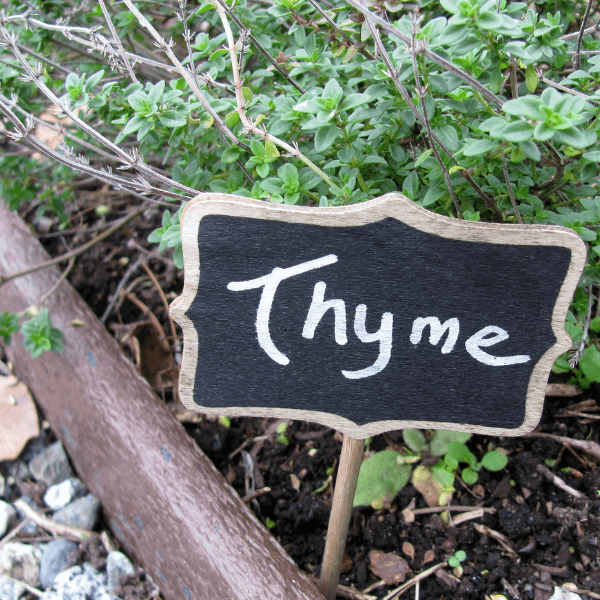
Thymus is a genus of many species of aromatic herbs in the mint family, Lamiaceae. It is native to the Old World and are prolific in Europe, Africa, and Asia.
The most common form of thymus found in gardens is Thymus vulgaris (common thyme). Other notable forms include Thymus Serpyllum (wild thyme), Thymus pulegioides (lemon thyme), and Thymus citriodorus (orange thyme).
Thymus is an evergreen herb that typically grows to 6-12 inches tall. The leaves are small and oval-shaped, and the flowers are white or pink. The plant has a strong, pungent scent used in many perfumes, soaps, and potpourris.
Thymus has medicinal properties and used to treat various conditions for centuries. The plant's essential oils are beneficial in aromatherapy to relieve stress and promote mental clarity. In addition, thymus is also a popular ingredient in many Italian dishes.
Thymus is easy to grow and makes an attractive addition to any garden. The plant prefers full sun and well-drained soil.
Origanum is a genus of over 30 species of aromatic herbs in the mint family, Lamiaceae. It is native to the Old World and are abundant in Europe, Africa, and Asia.
The most common form of oregano found in gardens is Origanum vulgare (common oregano). Other notable forms include Origanum heracleoticum (Greek oregano), Origanum majorana (sweet marjoram), and Origanum onites (pot marjoram).
Origanum is an evergreen herb that typically grows to 2-3 feet tall. The leaves are dark green and ovate-shaped, and the flowers are white or pink. So, this plant has a strong, pungent scent used in many perfumes, soaps, and potpourris.
Origanum is popular for its medicinal properties; it relieves various conditions for centuries.
The plant's essential oils are useful in aromatherapy to relieve stress and promote mental clarity. In addition, oregano is a popular ingredient in many Italian dishes.
Once you've finished planting, be sure to water your rockery well. Water alpine plants regularly, so check on your rockery often and water as needed.
Now that you've built your very own rockery, it's time to sit back and enjoy the fruits of your labour. Be sure to take care of your rockery by watering it regularly and removing any weeds or grass that may try to grow through.
With a little love and care, your rockery will be a beautiful addition to your landscape for years to come!
For All Your Landscaping Needs, There Is Only One Name to Trust - Landscaping St Catharines!
We are a full-service landscaping company servicing the Niagara Region for over 30 years. We offer a wide range of services, from design and build to maintenance and construction.
No matter your needs, we have the experience and expertise to do the best job.
So, if you're looking for someone to help you create your dream landscape, look no further than Landscaping St Catharines. We will work with you every step, from initial design to finished product. We take pride in our work and guarantee your satisfaction.
For all your landscaping needs, trust the experts at Landscaping St Catharines!